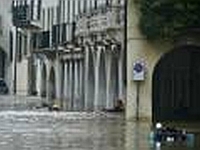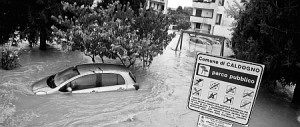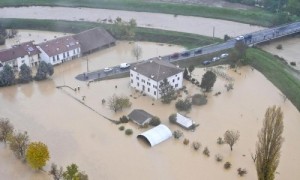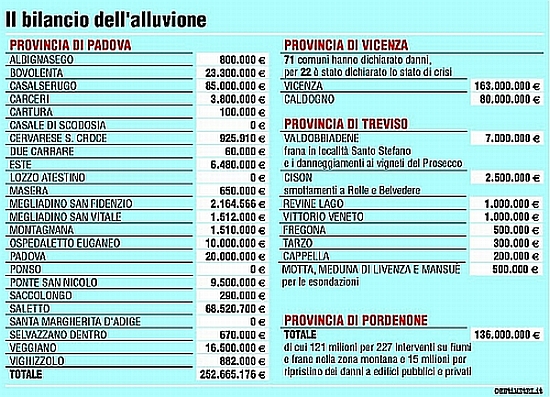The big water event in the Veneto region in November has had nothing to do with Venice and high water and the temporary walkways and how inconvenient or amusing the tourists find it and how aggravating it is for the merchants to deal with some water on the floor for a few hours.

The real story, which is still unfolding in all its drama and grief, has been the catastrophic flooding in large areas of the region caused by diluvial rains and overflowing rivers.
I mention this as part of my modest personal crusade to give acqua alta some useful context for people beyond the old Bel Paese who read the endless and fairly repetitive articles on Venice. I’d like to provide some recent perspective on the subject of water in these parts.
On November 1 the sky fell on the Veneto region. I actually can’t remember whether we got acqua alta in Venice — if we did it couldn’t have been a problem. But what happened out beyond the shoreline showed, at least to me, that anyone living near a river is going to be facing bigger and uglier problems than anybody does in Venice when the tide comes in.

Areas in or near Vicenza, Padova, Treviso, the mountains of Belluno and the countryside around Verona have been declared disaster areas. In a 48-hour period 23 inches of rain fell on Belluno, 21 inches on Vicenza, 15 inches on Verona, 14 inches on Treviso. Roughly the amount that falls in a normal year.
The total damage to houses, property, municipal infrastructure and agriculture in the Veneto has been estimated (this will undoubtedly increase) at over one billion euros ($1,365,530,000).
Garbage: Many of the Veneto’s 200 km (124 miles) of beaches, usually covered by vacationing Germans and other families, are now covered by seven million tons of garbage deposited by the swollen rivers emptying into the Adriatic. By “garbage” I don’t just mean bags of coffee grounds and orange peel but plastic of every sort, sheets of metal, uprooted trees.
Experts meeting in Treviso are trying to figure out not only how to remove this amount of material, but how the sam hill to pay for getting rid of it, seeing that this type of trash costs between 170 and 180 euros ($232 – $245) per ton to destroy. I’ll help you out: That comes to more than one and a half billion dollars just for the garbage. I’ll send them a contribution but it probably wouldn’t pay for destroying more than a shopping-bag’s worth of detritus.
Mudslides: That amount of rain has drastically undermined the character of the land in many places. Cleaning up and consolidating the areas of mudslides is another entire problem which will cost an amount of money I’m not going to bother calculating.
Businesses: On their knees. Loss of merchandise, damage to buildings and interruptions in transport have immobilized many businesses. Parts of many roads are still under water.

Agriculture: Fields and crops destroyed. Some 500 farming operations are now at risk of going out of business. The government has estimated the damage at 25 million euros ($34,138,250).
I realize that you can replant sugar beets and chardonnay grapes but you can’t replant the Doge’s Palace, should water ever inflict comparable damage on this incomparable monument. But still.
Very recently, but before all this happened, Giorgio Orsoni, the mayor of Venice, took a trip to Rome to make the rounds of government ministers and rattle the tin cup. He didn’t come back with much, and now the future will inevitably be even more austere. It’s not hard to picture how urgent it’s going to seem to preserve a couple of palaces and churches to a government struggling to help an estimated 500,000 people get their lives back.


6 Comments
Thank you for putting matters into perspective. Mother Nature can be cruel, it seems.
And you know we hear nothing of this here at all. Thanks for the update..glad you are safe
Benedicyt
That’s why I wanted to write this post, I assume that most of the world isn’t keeping up with all the news from out here, except for the same old stories about acqua alta. And by the way, I forgot to mention the damage to the fishing industry from the junk the rivers dumped into the sea. Estimates are about 5 million euros’ worth.
What a terrible disaster for the people of the Veneto. The only upside is that Venice had the wisdom (learned from hard experience) to reroute the river AROUND the lagoon and out to the sea centuries ago, or all of that would likely have devastated Venice as well. Today, the “environmental protection agency” would have prevented that “fix”. Prayers for the people!
To be fair, the main reason Venice re-routed the rivers was to prevent the lagoon from silting up. Their wisdom was to perceive that the water ultimately was their ally, and that living in a city surrounded by wheatfields would be a million times more dangerous in the long run than having some water occasionally in the streets.
this page was precisely what i’ve been looking regarding! I found this blog bookmarked in a friend of mine. im going to also share it. with thanks again!